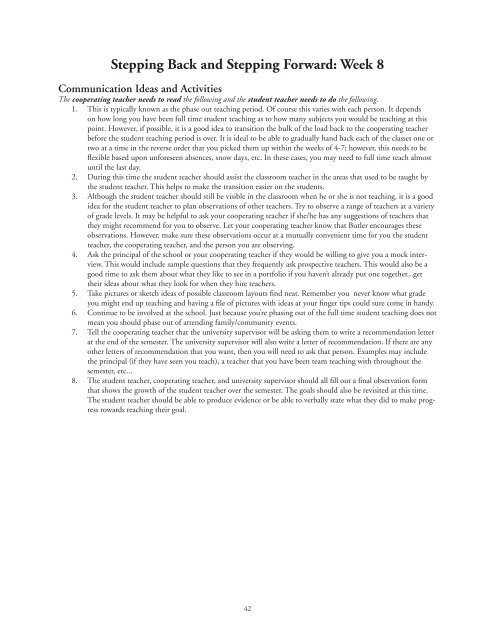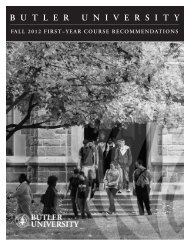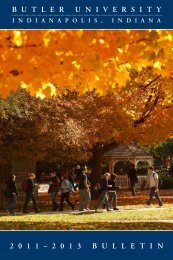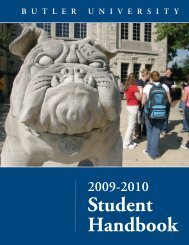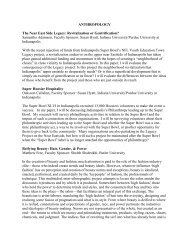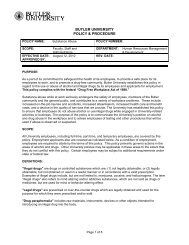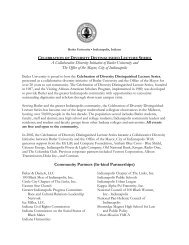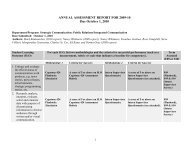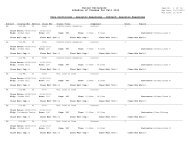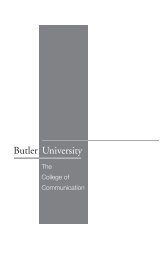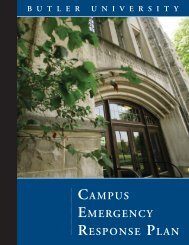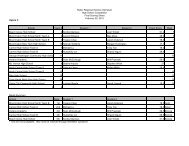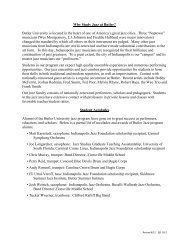Student Teaching Handbook - Butler University
Student Teaching Handbook - Butler University
Student Teaching Handbook - Butler University
Create successful ePaper yourself
Turn your PDF publications into a flip-book with our unique Google optimized e-Paper software.
Stepping Back and Stepping Forward: Week 8<br />
Communication Ideas and Activities<br />
The cooperating teacher needs to read the following and the student teacher needs to do the following.<br />
1. This is typically known as the phase out teaching period. Of course this varies with each person. It depends<br />
on how long you have been full time student teaching as to how many subjects you would be teaching at this<br />
point. However, if possible, it is a good idea to transition the bulk of the load back to the cooperating teacher<br />
before the student teaching period is over. It is ideal to be able to gradually hand back each of the classes one or<br />
two at a time in the reverse order that you picked them up within the weeks of 4-7; however, this needs to be<br />
flexible based upon unforeseen absences, snow days, etc. In these cases, you may need to full time teach almost<br />
until the last day.<br />
2. During this time the student teacher should assist the classroom teacher in the areas that used to be taught by<br />
the student teacher. This helps to make the transition easier on the students.<br />
3. Although the student teacher should still be visible in the classroom when he or she is not teaching, it is a good<br />
idea for the student teacher to plan observations of other teachers. Try to observe a range of teachers at a variety<br />
of grade levels. It may be helpful to ask your cooperating teacher if she/he has any suggestions of teachers that<br />
they might recommend for you to observe. Let your cooperating teacher know that <strong>Butler</strong> encourages these<br />
observations. However, make sure these observations occur at a mutually convenient time for you the student<br />
teacher, the cooperating teacher, and the person you are observing.<br />
4. Ask the principal of the school or your cooperating teacher if they would be willing to give you a mock interview.<br />
This would include sample questions that they frequently ask prospective teachers. This would also be a<br />
good time to ask them about what they like to see in a portfolio if you haven’t already put one together...get<br />
their ideas about what they look for when they hire teachers.<br />
5. Take pictures or sketch ideas of possible classroom layouts find neat. Remember you never know what grade<br />
you might end up teaching and having a file of pictures with ideas at your finger tips could sure come in handy.<br />
6. Continue to be involved at the school. Just because you’re phasing out of the full time student teaching does not<br />
mean you should phase out of attending family/community events.<br />
7. Tell the cooperating teacher that the university supervisor will be asking them to write a recommendation letter<br />
at the end of the semester. The university supervisor will also write a letter of recommendation. If there are any<br />
other letters of recommendation that you want, then you will need to ask that person. Examples may include<br />
the principal (if they have seen you teach), a teacher that you have been team teaching with throughout the<br />
semester, etc...<br />
8. The student teacher, cooperating teacher, and university supervisor should all fill out a final observation form<br />
that shows the growth of the student teacher over the semester. The goals should also be revisited at this time.<br />
The student teacher should be able to produce evidence or be able to verbally state what they did to make progress<br />
towards reaching their goal.<br />
42


